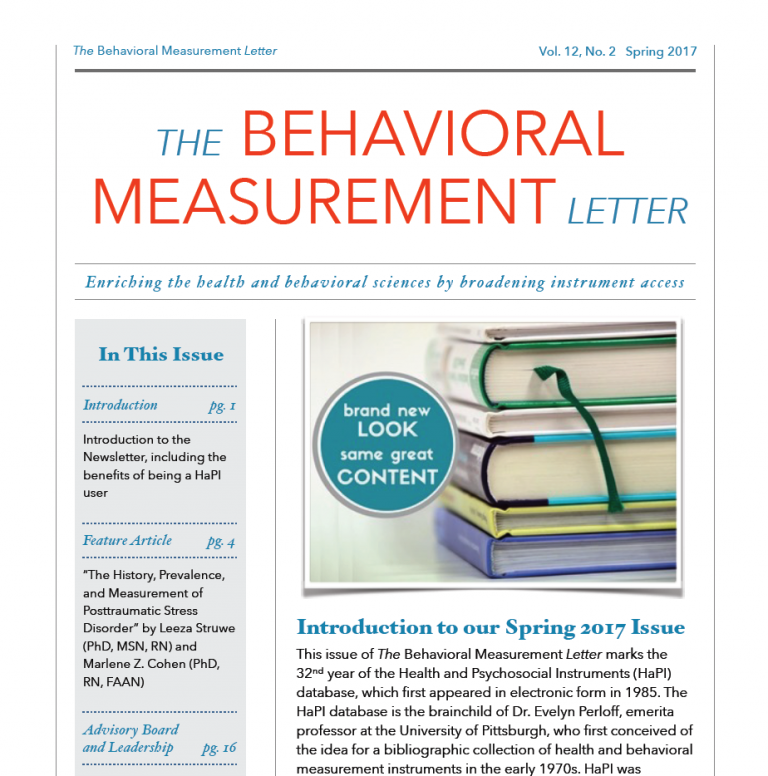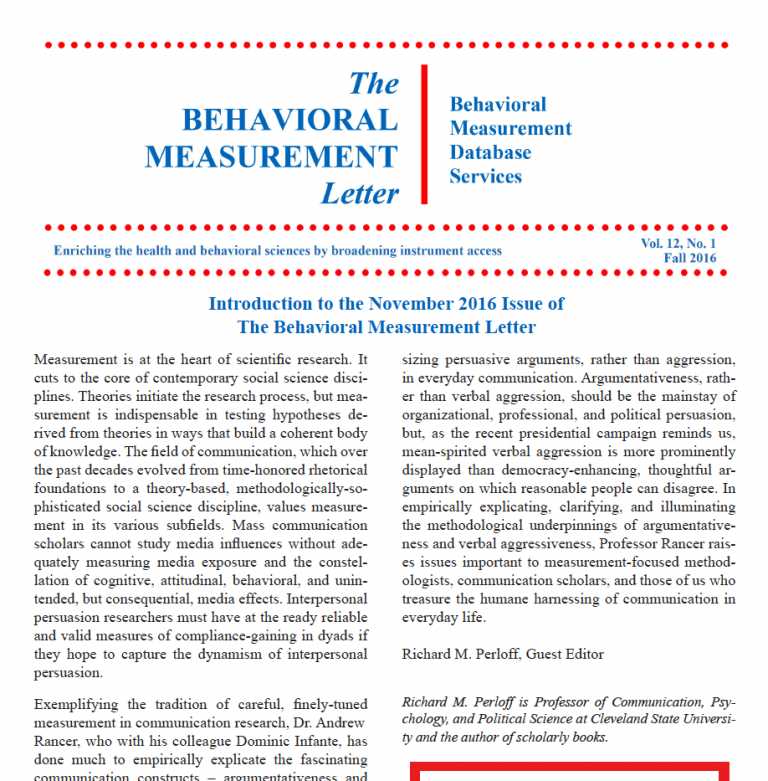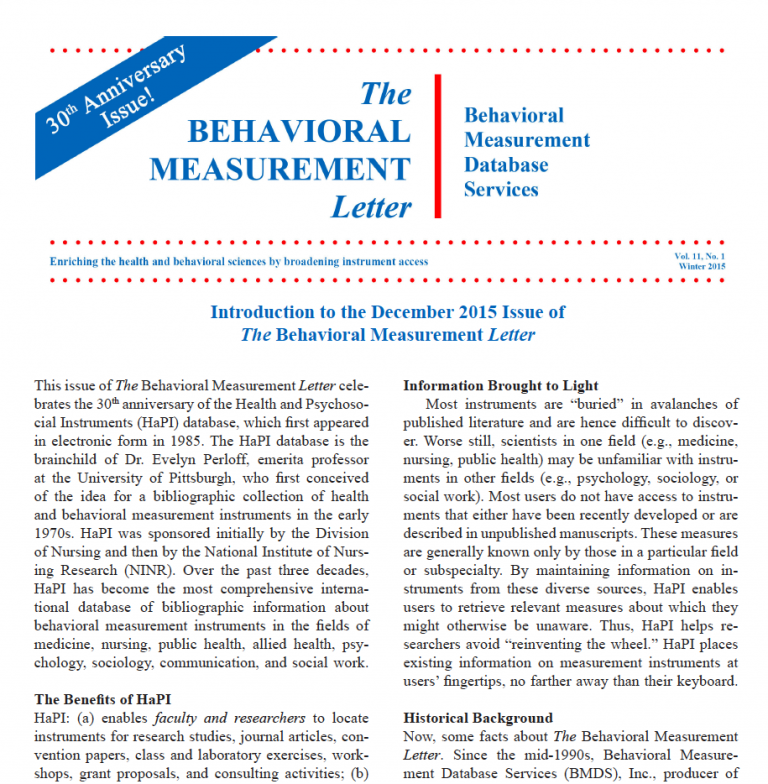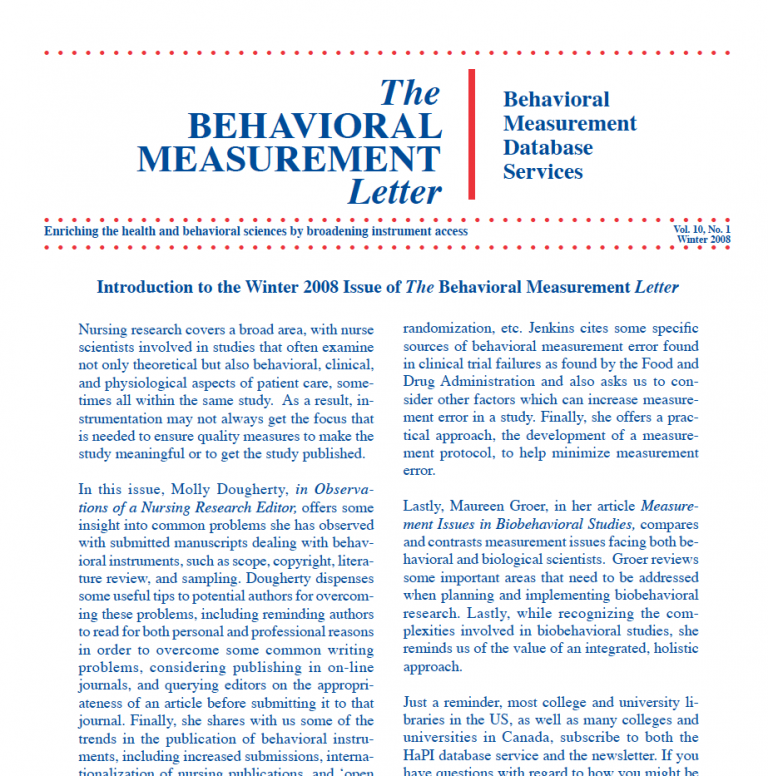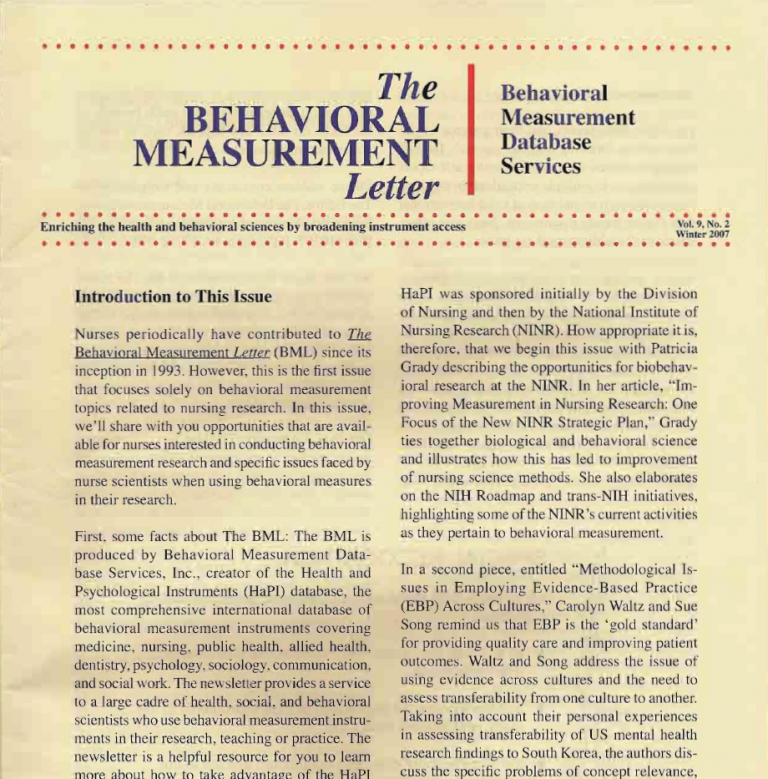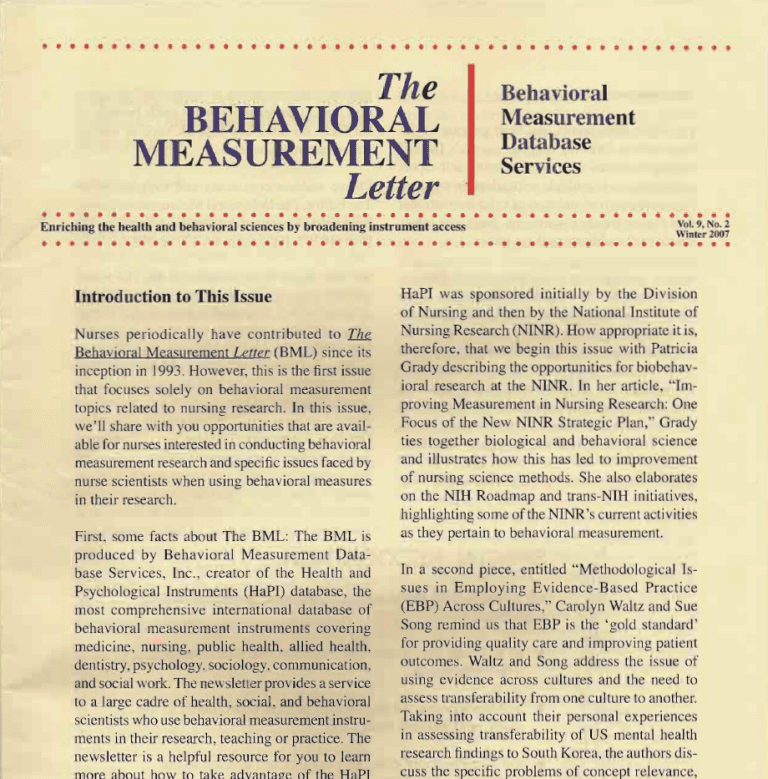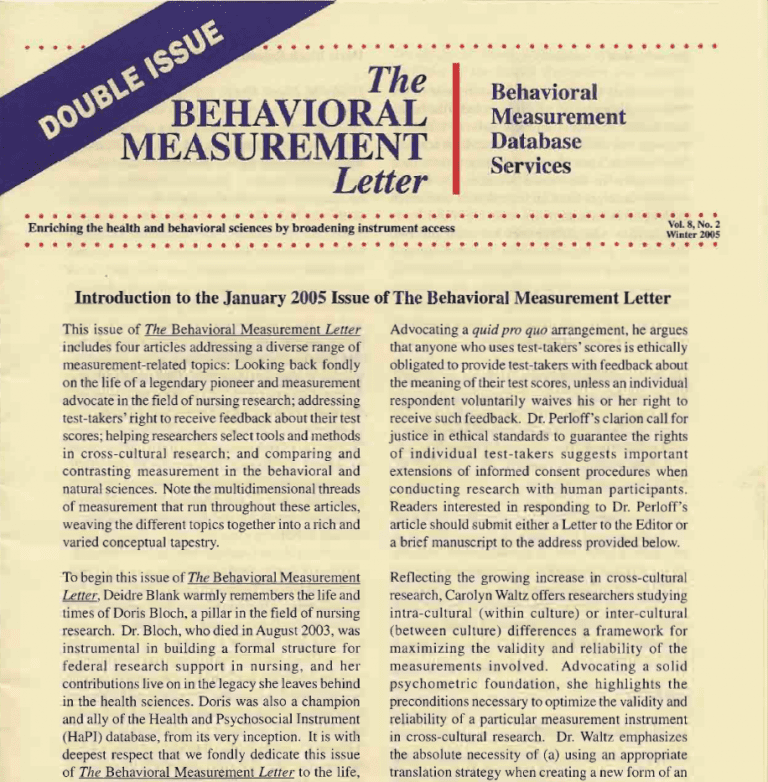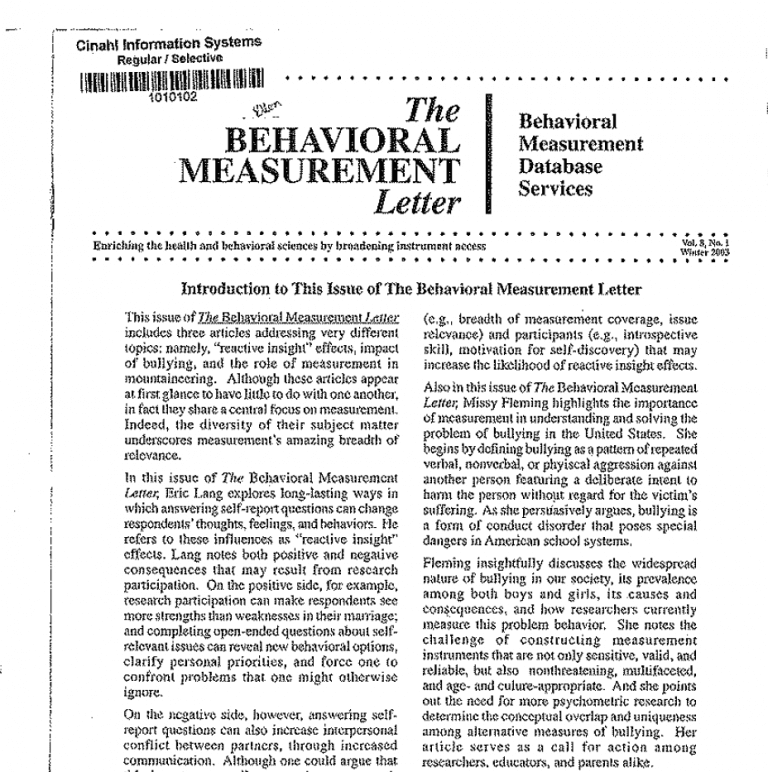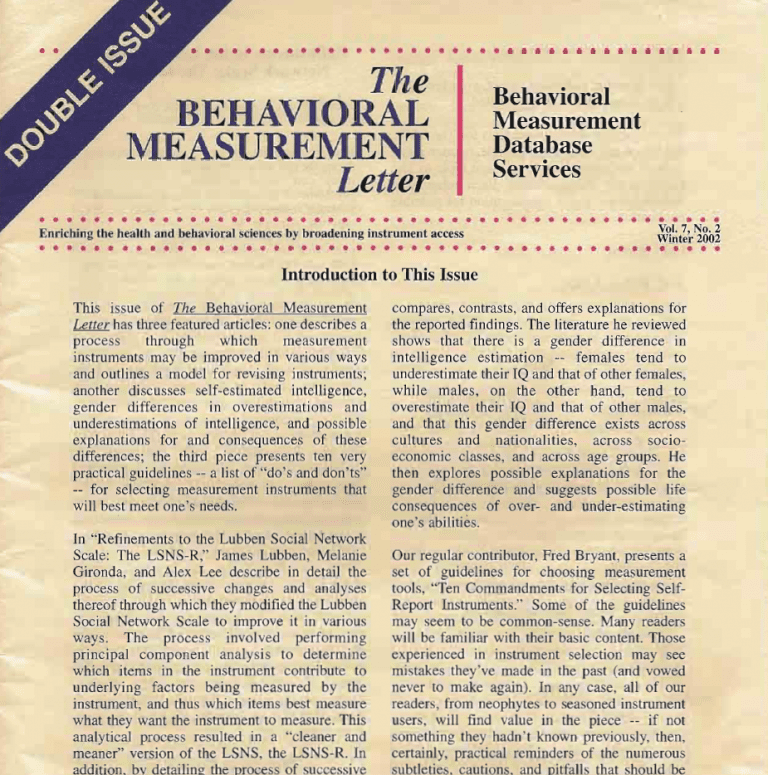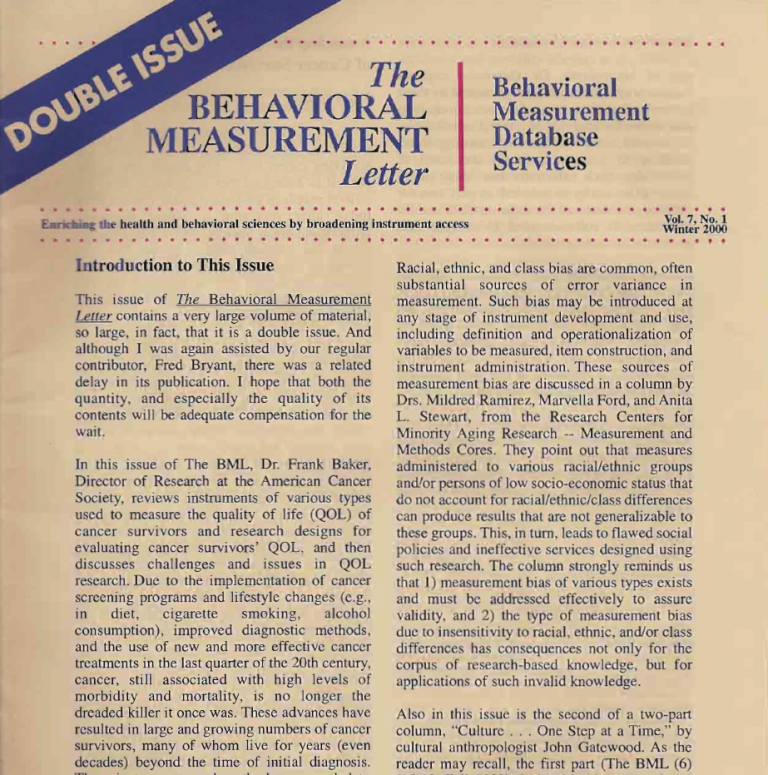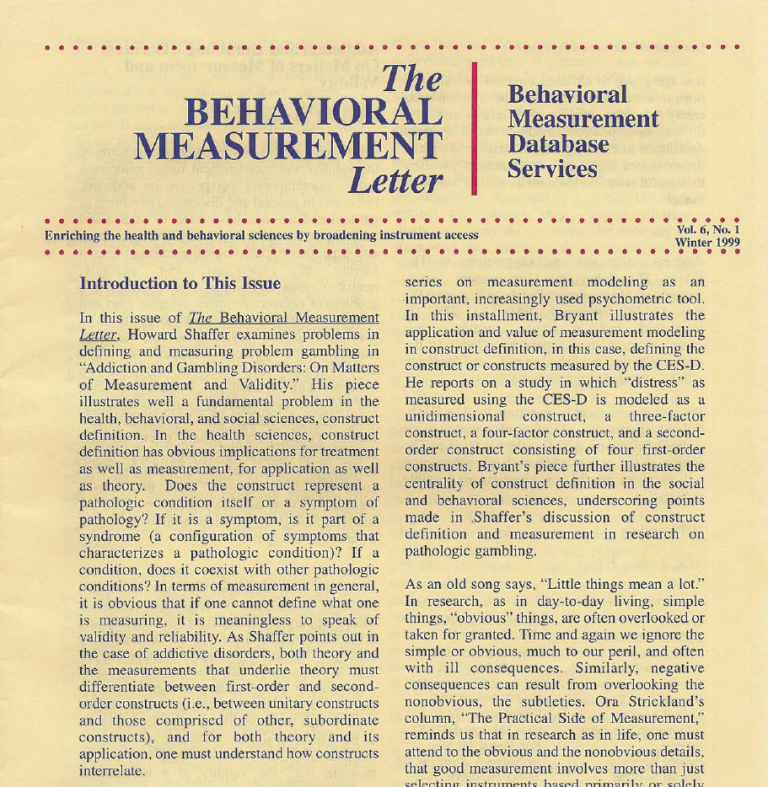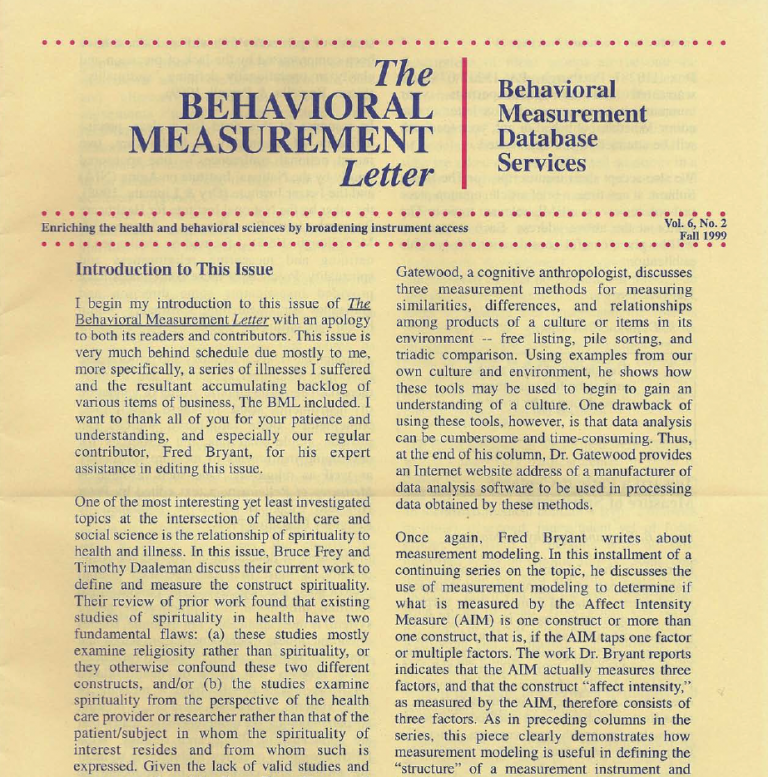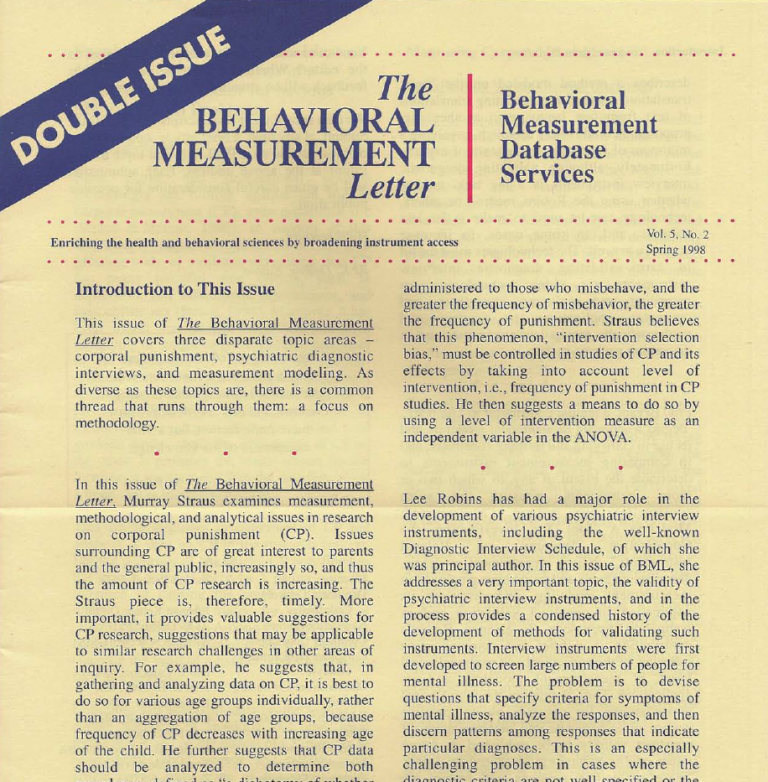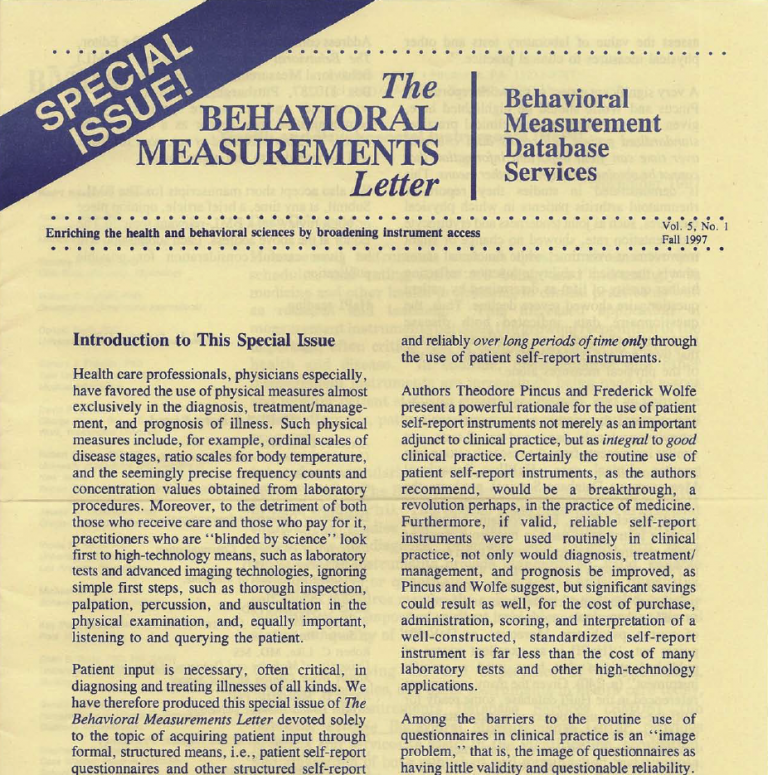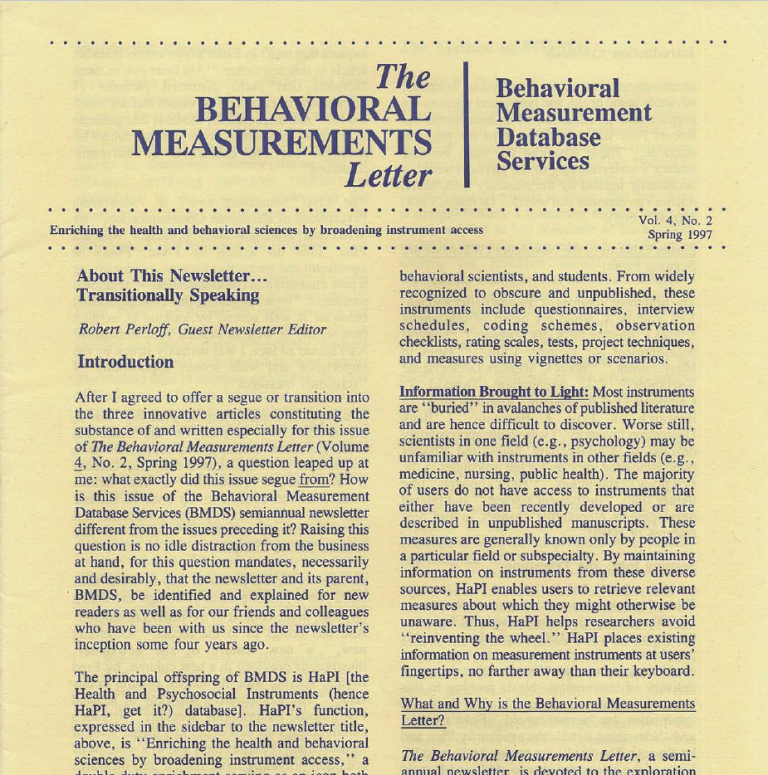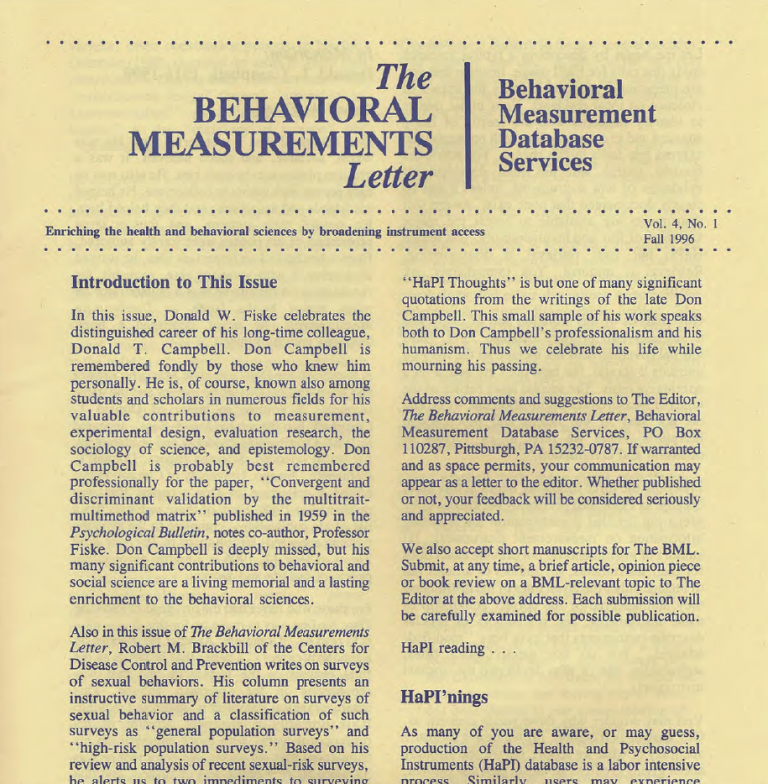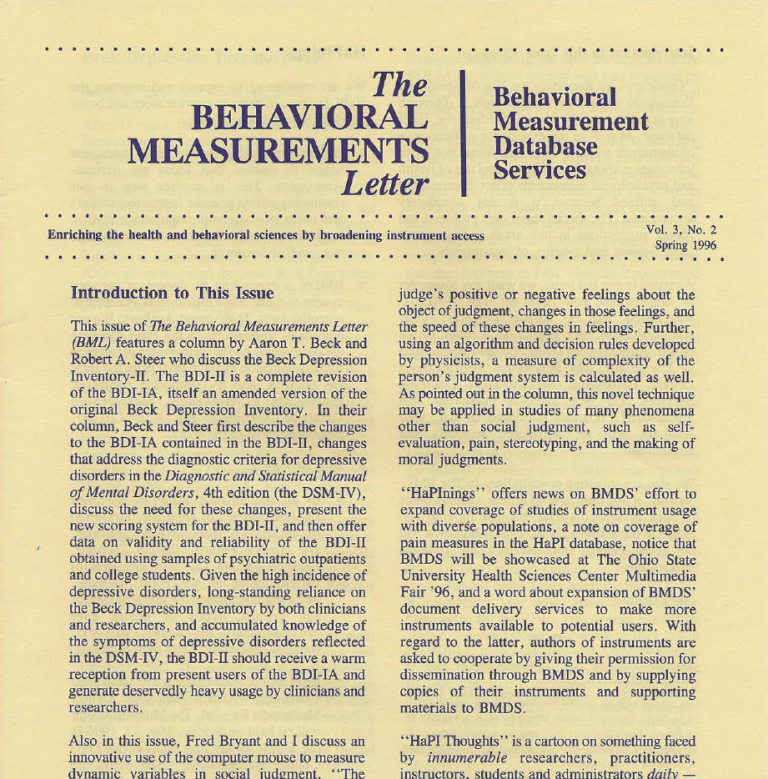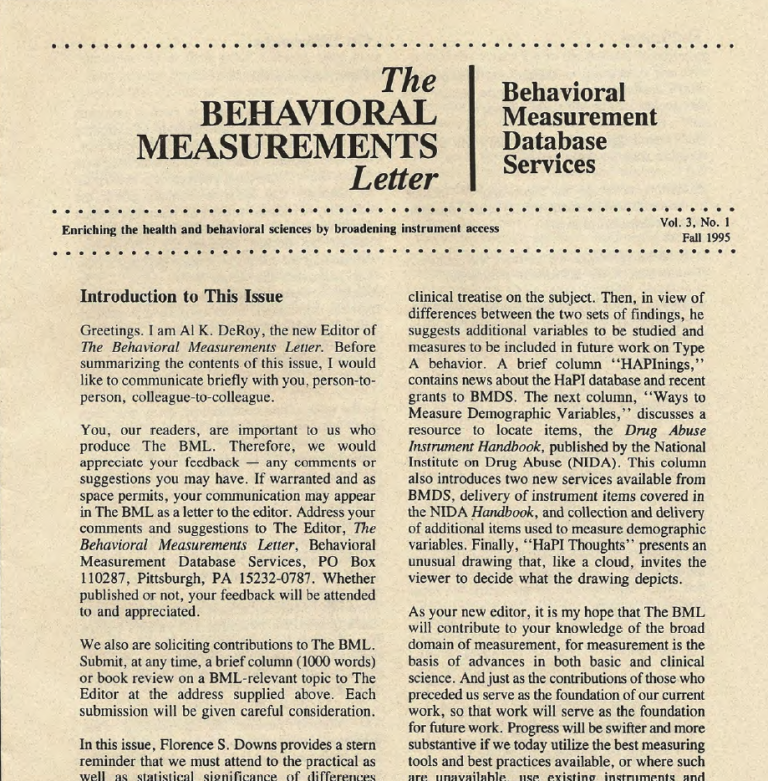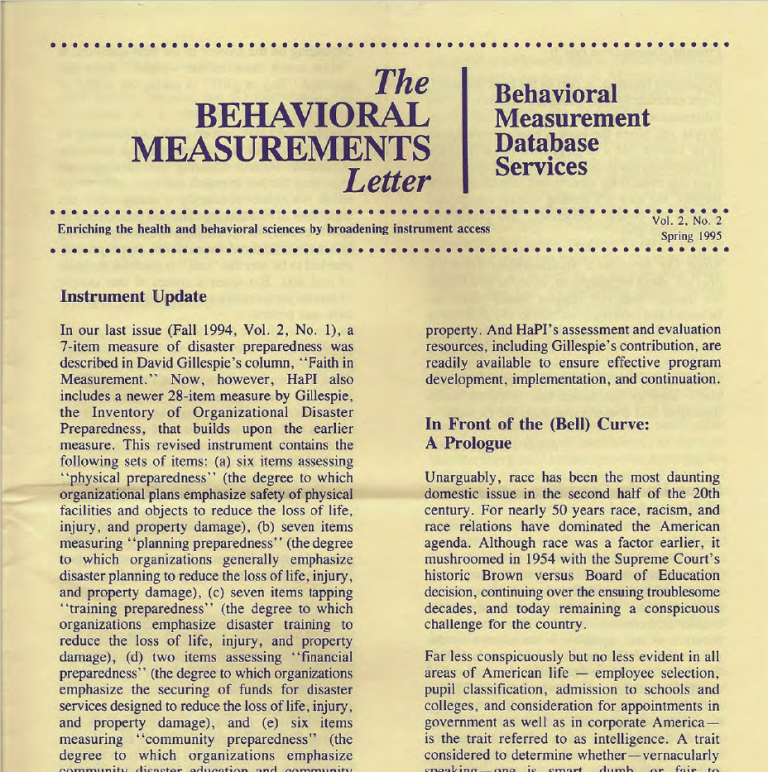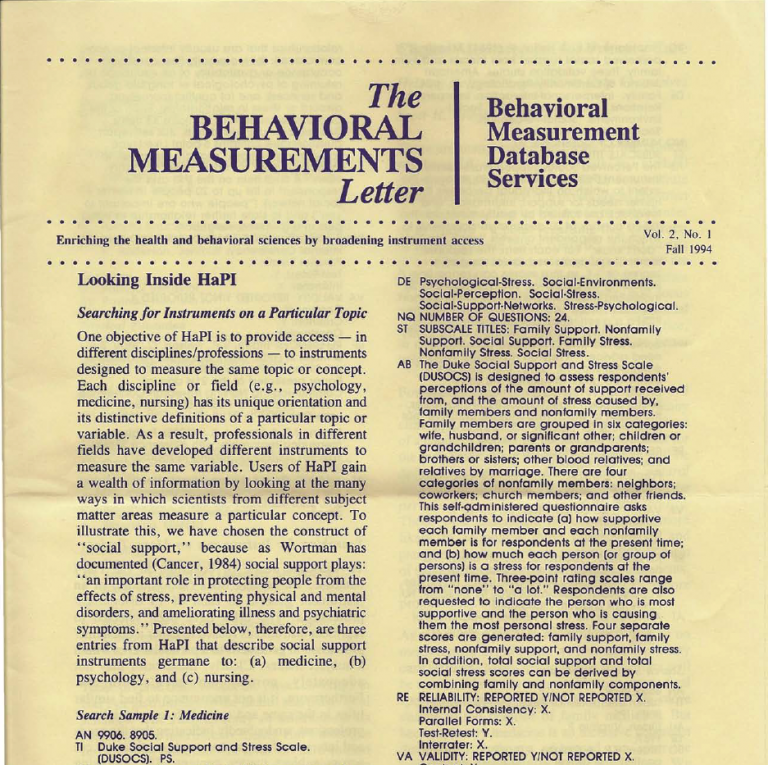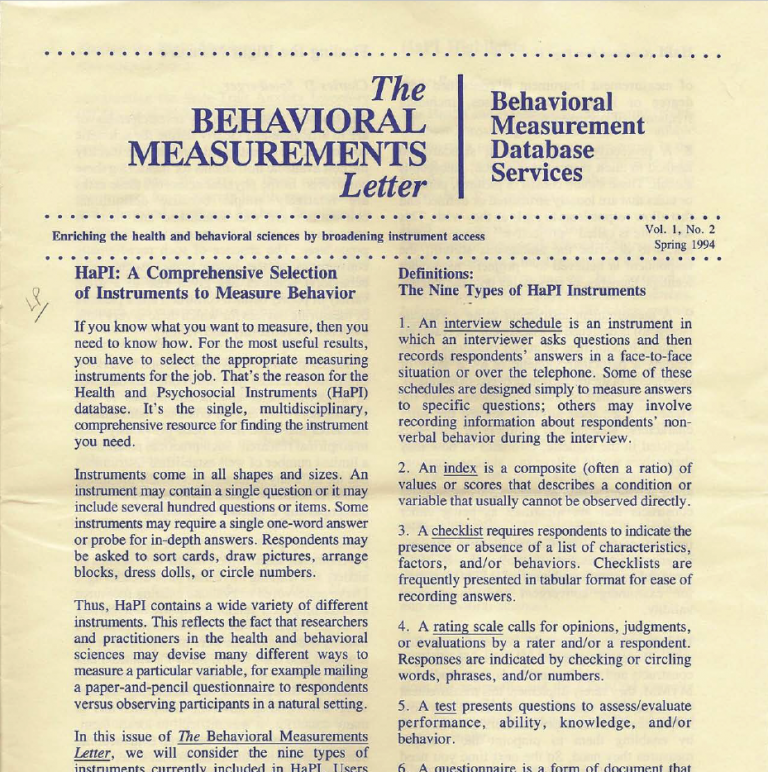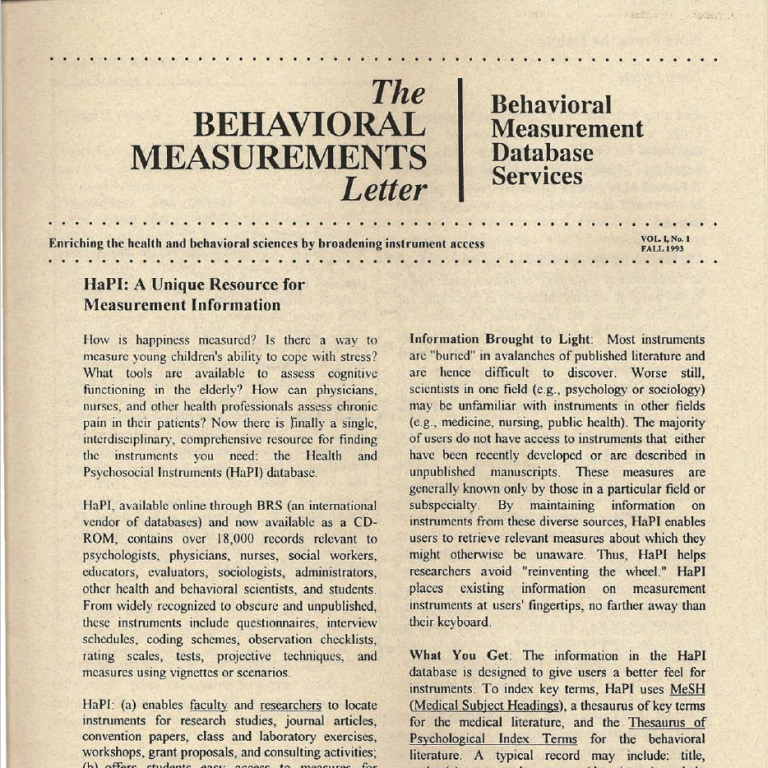Vol. 1, No. 1: Fall 1993
How is happiness measured? Is there a way to measure young children’s ability to cope with stress? What tools are available to assess cognitive functioning in the elderly? How can physicians, nurses, and other health professionals assess chronic pain in their patients? Now there is finally a single, interdisciplinary, comprehensive resource for finding the instruments you need: the Health and Psychosocial Instruments (HaPI) database.
HaPI, available online through BRS (an international vendor of databases) and now available as a CD ROM, contains over 18,000 records relevant to psychologists, physicians, nurses, social workers, educators, evaluators, sociologists, administrators, other health and behavioral scientists, and students. From widely recognized to obscure and unpublished, these instruments include questionnaires, interview schedules, coding schemes, observation checklists, rating scales, tests, projective techniques, and measures using vignettes or scenarios.
HaPl: (a) enables faculty and researchers to locate instruments for research studies, journal articles, convention papers, class and laboratory exercises, workshops, grant proposals, and consulting activities;
(b) offers students easy access to measures for papers, projects, theses, and dissertations, thereby enhancing learning and performance;
(c) helps practitioners identify instruments to facilitate assessment of client/patient problems and outcomes at individual and organizational levels;
(d) gives librarians and information specialists a measurement resource that cuts across disciplines and professions to meet user needs;
(e) allows authors to track use of their measures by others.
Information Brought to Light: Most instruments arc “buried” in avalanches of published literature and are hence difficult to discover. Worse still, scientists in one field (e.g., psychology or sociology) may be unfamiliar with instruments in other fields (e.g., medicine, nursing, public health). The majority of users do not have access to instruments that either have been recently developed or are described in unpublished manuscripts. These measures are generally known only by those in a particular field or subspecialty. By maintaining information on instruments from these diverse sources, the HaPI database enables users to retrieve relevant measures about which they might otherwise be unaware. Thus, HaPI helps researchers avoid “reinventing the wheel.” HaPI places existing information on measurement instruments at users’ fingertips, no farther away than their keyboard.
What You Get: The information in the HaPJ database is designed to give users a better feel for instruments. To index key terms, HaPI uses MeSH (Medical Subject Headings), a thesaurus of key terms for the medical literature, and the Thesaurus of Psychological Index Terms for the behavioral literature. A typical record may include: title, author(s}, source, key terms (descriptors) to .help users refine and/or continue their search, number of items in the instrument, subscale titles, an abstract that briefly describes the instrument, information on the instrument’s reliability and validity, and selected references. So the next time you need an instrument, don’t worry, just get HaPI.
Linda Perloff, Editor
Note From the Editor
Linda Perloff
This is the first issue of The Behavioral Measurements Letter, a semi-annual newsletter devoted to the exploration of timely measurement topics. The Behavioral Measurements Letter is published by Behavioral Measurement Database Services, producer of the Health and Psychosocial Instruments (HaPI) database.
The impetus for this newsletter sprang from our belief in the paramount importance of measurement. Just as in the physical sciences, advances in the health and behavioral sciences are proportional to advances in measurement. As Robert Pool stated in the case of the physical sciences, “These advances are vital, because science’s understanding of the physical world is necessarily limited by the accuracy with which science can measure that world” (Science, 1988, 240, 604-605).
Accurate measurement in the health and behavioral sciences is similarly crucial, because researchers and practitioners must also be able to quantify their abstract concepts (e.g., mental status, leadership, abuse, empathy, compliance, well-being) in ways that are precise, meaningful, dependable, and generalizable. We hope to help professionals in the health and behavioral sciences meet the challenges of their profession by improving their access to relevant measurement instruments and to interdisciplinary measurement issues. We plan to focus on everyday issues in measurement that researchers and practitioners encounter in their quest for instruments. Future issues will also provide readers with updates on what’s new in HaPI, selected new instruments from the database, and teaching tips for making measurement more exciting and meaningful for students. Each issue will feature guest columnists from different disciplines (library and information science, psychology, communication, nursing, medicine, sociology, social work, organizational behavior). Indeed, among the most important messages we hope to communicate with this newsletter is that measurement, a common bond linking all researchers, practitioners, educators, and evaluators, transcends disciplines and fields.
In Appreciation –
A Tribute to Doris Bloch
The computerized Health and Psychosocial Instruments (HaPJ) database would never have become a reality were it not for the vision of Doris Bloch, RN, Dr. PH, FAAN. She was the guiding light and efficacious advocate on behalf of HaPI at the National Institute for Nursing Research of the National Institutes of Health, an original sponsor of HaPI during its essential four-year developmental period. Dr. Bloch, who received her doctorate in public health from the University of California at Berkeley, is now Special Assistant to the Center’s Director. During those early days when HaPI was undergoing its initial development, it was Doris Bloch’s ability to anticipate and help resolve complex issues, along with her extensive background and sophistication in measurement and evaluation throughout the health sciences, that played a decisive role in the birth and sustenance of HaPI. An exemplary role model steadfastly reflecting the highest ethical standards, scholarship, and practice, Dr. Bloch’s efforts on behalf of HaPI and many other endeavors identify her as a distinguished contributor to measurement and evaluation.
“The union of the mathematician with the poet, fervor with measure, passion with correctness, this surely is the ideal.”
William James (1879)
Using HaPI with Other Social Science Databases
William J. Paisley
The usefulness of social science databases is well known to researchers who find the references they need in minutes with a PC rather than hours in the library. With the help of well-screened search results, the trip to the library stacks to read the retrieved articles becomes a more enjoyable last step. Literature reviews are more comprehensive. New research projects build on the most recent findings of other investigators.
I have a new Public Health Service grant to compile information on health promotion programs focusing on key health problems such as cancer and cardiovascular disease. Although I have been active in this research area for almost 20 years, scores of relevant studies from many countries are added to this literature every year. My research must begin with a thorough search of the social science databases.
For years my preferred database for this type of search has been the Social Sciences Citation Index, which has a broad interdisciplinary coverage that saves some effort in searching all the disciplinary databases. Thanks to SSCI’s unique Cited Reference field, I can use a recently completed study as my entry point, work backwards to its key references, then search forward again to other recent studies that cite the same earlier work. As references lead to references, this backwards-forwards tracing helps to fill in a survey of current research activity.
The HaPI database recently came to my rescue when I was having difficulty with one concept; cardiovascular knowledge or heart disease knowledge. There are no hits on these terms perse in the SSCI, although I know that many relevant articles are waiting to be found there.
I loaded HaPI in the library’s CD-ROM reader and searched on cardiovascular knowledge. This was a three-step process, because I wanted to be sure that I found these terms in any field (e.g., title, abstract, descriptors) where they occur. First I ran down all occurrences of knowledge, which totaled 616 in these fields. Then I searched cardiovascular or heart disease, which totaled 115 occurrences. I combined these hits with what the librarians call Boolean “AND” logic, to pinpoint the instruments and studies that deal with both concepts. There were 27 occurrences at this intersection.
When I scanned the results, many of the 27 references proved to be good candidates for the SSCI search that followed. For example, a 1989 article in Health Education Quarterly by J. D. Killen and associates, “The Stanford Adolescent Heart Health Program,” is represented in the HaPI database under the informative title, “knowledge of cardiovascular disease risk concepts”‘.
I turned to SSCI with the Killen et al. article as the first entry point. It contained 61 references, several of which were “roots” to later studies. However, the results were even richer when I searched on Killen et al. as the cited reference. Eight recent studies cite Killen et al. One of these is an integrative review of cardiovascular disease, risk reduction, knowledge, etc. by B. L. Tinsley (Child Development, 1992). It contains 164 references!
This first search is not “the beginning of the end,” as Churchill said, “but only the end of the beginning.” The interplay between HaPI and other social science databases makes it possible to identify important
William J Paisley is cofounder of the electronic publishing company, Knowledge Access, Inc. He received his PhD in communication research from Stanford University. Dr. Paisley’s areas of specialization include public knowledge and the flow of scientific and technical information.
A Welcome From HaPI’s Director
Evelyn Perloff
I am excited by the realization that we can now communicate regularly with users of HaPI through The Behavioral Measurements Letter. The principal objective of HaPI is to provide measurement information to librarians, researchers, educators, pract1t1oners, administrators, evaluators, and students in the health and behavioral sciences. We urge you to raise questions and keep us informed about your interests and needs, as they relate to HaPI and to The Behavioral Measurements Letter. We will respond as quickly and completely as possible. I also wish to share with you that the realization of HaPI and now The Behavioral Measurements Letter are two dreams come true. It has been over 20 years since the first words about a possible database of instruments were put to paper. It has been much longer, l assure you, when as an undergraduate chemistry major I learned to appreciate that to measure is to begin to know (even with errors of measurement). This orientation then became a foundation for how I thought and how I behaved, and since I have never found a better way to know, I continue to remain bullish about HaPI’s capacity to enable us to do a better job of knowing. Indeed, I believe that HaPI has the potential for advancing our understanding of the underpinnings of health and behavior by enabling us to operationally define and quantify abstract concepts more accurately.
Read additional articles from this newsletter:
Evolving Issues in Instrumentation for Nursing Research

